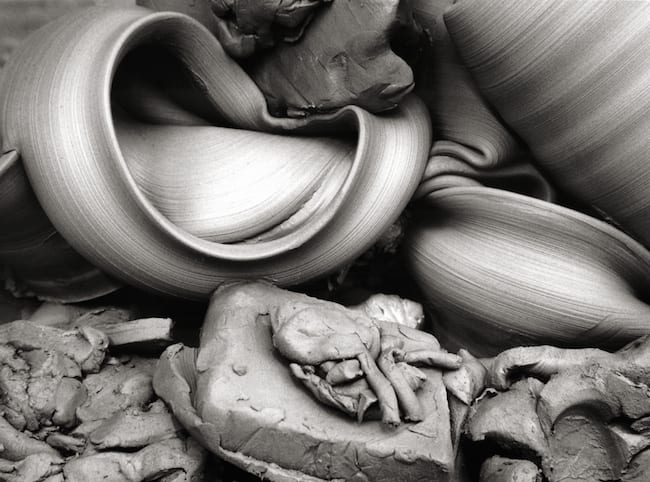I would not have imaged this five years ago but the Gardiner Museum is in ascendancy, the leading dedicated ceramics space in North America with a program of intriguing, envelope pushing and unexpected exhibitions.
Above image: Chris Curreri, Untitled (Clay Portfolio), 2013, gelatin silver print, 7 3/4 x 5 3/4 in., from a portfolio of 21 images
As part of the Scotiabank CONTACT Photography Festival, acclaimed Toronto-based multi-media artist, Chris Curreri, is exhibiting striking photographs taken in 2013 while he was attending weekly clay classes at the Gardiner Museum. Curreri photographed the other students’ wet, discarded projects, capturing raw materials in different states: fresh and untouched clay; mounds of bowls and other objects; and the process of recycling this matter into new, usable material.


The images were first shown in Toronto at the artist’s second solo exhibition at Daniel Faria Gallery. In a review in Art in America, Milena Tomic explains the link she sees in this work to informe:

Chris Curreri, Medusa, 2013, cement, 21 x 23 x 12 inches
“In the 1996 exhibition “Formless: A User’s Guide” at the Centre Georges Pompidou and the influential book that accompanied it, Rosalind Krauss and Yve-Alain Bois defined the informe (or formless) as a de-sublimating “operation.” While sublimation, in psychoanalytic terms, is the redirecting of libidinal impulses toward more respectable aims, with tangible social benefits, de-sublimation functions in the opposite direction. For Krauss and Bois, the informe works to decouple form and content, divesting painting and sculpture of their styles and subjects, and revealing the instinctual energies that are inherent to the process of making but are often repressed in the final result.
“The work Curreri exhibited in this show accomplishes something similar to the informe. Depicting its subjects amid transformation, the work exposes the raw energies or materials that are tamed in order to create identities, objects or spaces more compliant with the human social realm. One photograph in Untitled (Clay Portfolio), for instance, shows a mound of clay remnants. Despite the mound’s overall shapelessness, form insinuates itself into the picture by way of a single intact jug in the mound’s lower left corner, reminding viewers that this mess of material will soon be smoothed out and then shaped into various, discrete objects on potters’ wheels.”
Some of the prints have a subtle solarization effect—a phenomenon in photography in which the image is wholly or partially reversed in tone by exposing the print to light during the development process. This process underscores a correspondence between the photographic darkroom and the pottery studio by emphasizing the brief moment where the image is still malleable and has yet to be fixed to the photographic paper.
What makes this show a different outing for the photography is that the installation in the Museum Lobby, entitled So Be It, also features an ambitious new sculptural work by Curreri—his first piece of ceramic art. That is usually not a good admission, the “first” often ushers in amateur hour but Carreri pulls it off. It is a an 800 pound pile of clay comprising discarded vase forms and other clay bits and pieces measuring eight feet long. Again the idea can be a cliché (and a frequently used one at that) but there is an elegant lyrical quality the sculpture that makes this a memorable and assured work.
“It’s special to be exhibiting these photographs in the place where they were taken. It feels like they’re coming home,” says Curreri. “The sculpture was quite daunting because of its size, but I’m excited about the result. It expands upon the relationship between raw material, latency, and finality that’s introduced in the photographs.”
“Chris Curreri’s installation bridges the artistic visions of the Gardiner and the Scotiabank CONTACT Photography Festival seamlessly,” says Kelvin Browne, Executive Director and CEO of the Gardiner Museum. “The works explore the potential of clay as both an artistic medium and as a beautiful and dynamic photographic subject matter.”
Perhaps the most intriguing aspect of the exhibition is how different the photographs are from the sculpture. One would expect a certain feeling of redundancy. They are related in subject, and are complimentary in this setting, but distant in every other sense. The lens and Curreri’s dispassionate eye have made images that are not mere records of the clay but artworks in their own right, distant from the muddy reality alongside them.

Chris Curreri studied photography at Ryerson University before completing a master’s degree at Bard College. He has exhibited locally and internationally, and his work is included in the permanent collections of the Art Gallery of Ontario (AGO); the Agnes Etherington Art Centre, Queen’s University; Hart House, University of Toronto; TD Bank; and Royal Bank of Canada. He was shortlisted for the 2014 Sobey Art Award.
Garth Clark is Chief Editor of CFile
Any thoughts about this post? Share yours in the comment box below.

Chris Curreri, Beside Myself, 2011, chromogenic print

Chris Curreri. Photograph by Andrew Francis Wallace, Toronto Star.






What incredible skill, craftsmanship, artistry and imagination, It means so much, it’s so deep! A slops bucket!
Photos of your work help me understand the ceramic work my son is doing . I call my son’s work “free form”. He doesn’t seem to like having labels placed on his labors.